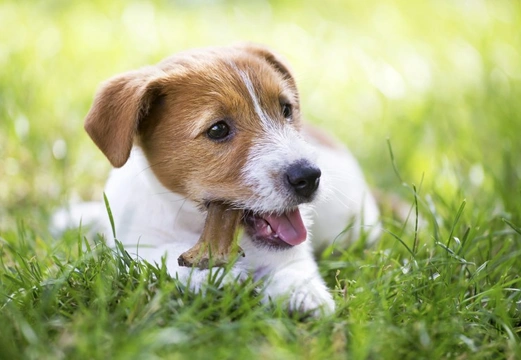
The importance of teeth in your dog
Teeth play a very important role in a dog’s life, right from puppyhood through to their senior years. They all have a part to play in keeping a dog healthy and a lot of care and attention is needed to keep them well through their entire body.
The importance of teeth started when dogs were in the wild and much more like hunters, having to use all of their skills in order to eat. You could say that teeth are a classic example of biological engineering, as without them, they would find it hard to survive.
Just as in human teeth, they need to be cared for and regularly cleaned and plaque removed as best as possible. Some of the foods that dogs enjoy help in the cleaning ritual, particularly bones and certain treats available on the market. Regular inspection of your dog’s teeth can be critical to their health.
The construction of canine teeth is very similar to that of a human being as is the fact that they have two sets in their lifetime – baby teeth and adult teeth which are designed to serve every purpose needed at different stages of their lives. A very useful factor for anyone purchasing a dog is being able to tell approximately how old that dog is – important when rehoming a dog or buying one from someone you don’t know.
Puppy teeth
A puppy’s teeth are like those of a baby, they just happen to get them a lot earlier than humans, it can be a matter of just a few weeks after birth. They only have 28 teeth in puppyhood, as they do not require molars at the back in early times. You will often find puppy teeth scattered around the house, as they fall out easily due to the lack of strong roots. You will know when a puppy playfully chews on you – their teeth are so sharp! They remain in place until around 4 months old, when they are replaced with adult teeth for the rest of their lives.
By the age of approximately 6 months old, your dog will have 42 teeth, 10 more than a properly formed adult jaw!
Types of adult dog teeth
Split into 4 different types, each group of teeth have a different purpose in aiding your dog’s dietary process. These groups are incisors, canines, pre-molars and molars, starting from the front and in that order. When a dog ‘smiles’ the most prominent teeth are the canines, which in some cases can be 5-6cm from root to tip (in the case of a very large dog).
What are the incisors used for?
Incisors are used for the ‘least’ important eating function, if you can say that. As dogs get older, they frequently lose incisors, but this does not stop them eating their food or breaking food down. The incisors at the front have two functions – removing items from their coats such as unwelcome visitors (fleas), and ‘scraping’ the final tasty bits from bones. They also function as a ‘pick up tool’. A dog will pick up at the front of his mouth and then frequently transfer hard items to the back before demolishing.
Canines
These teeth appear amongst the incisors and are fang-like in appearance, with two on the top part of the jaw and two on the bottom. Used as ‘grippers’, they are extremely strong, and once a dog has a toy or a bone in his mouth, the canines spring into action and any item within their grasp is very hard to remove! In the wild, these teeth were of prime importance to prevent the dog from losing any prey he had hunted down.
Pre-molars
If you have ever watched your dog in the process of eating a chewy morsel such as a dog treat, or a rawhide bone, he accepts it at the front of his mouth and rapidly moves it to the side for the chewing action. Any food that needs mastication will follow this action in order to break it down or to rip it into shreds. To a certain extent, you could say these teeth are the most important in the dietary function. Located just behind the canine teeth, the fact that there are 16 in total shows their importance.
Molars
These are the ‘hard grafters’ of a dog’s teeth – they literally do all the hard work in order to help the digestive process. There are 10 in total, with 6 of them being located on the lower jaw. Bones don’t stand a chance once gripped between these teeth and the grinding process begins. When you watch a dog eating a bone you can all but see the action. The ability to break down hard food to tiny pieces prevents unwanted splinters lodging in your dog’s stomach (hopefully). This action also creates saliva, which is also extremely important for a dog’s health.
Whilst still of paramount importance, since the domestication of dogs the functionality of each group of teeth has lessened in terms of the fact that dog food is now mass produced in cans and trays either loaf style or ‘casserole’ style, with no chewing needed. Manufacturers have encouraged the use of ‘wet food’, even mixer biscuits are now made in softer style. However, the wild instinct still prevails, and there is no animal more contented than a dog with a bone.



